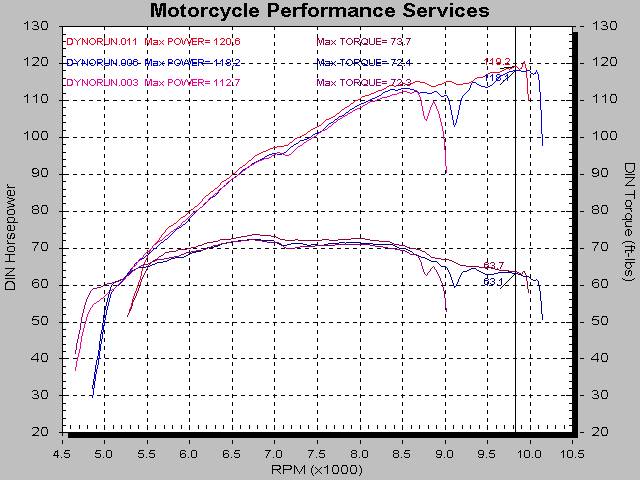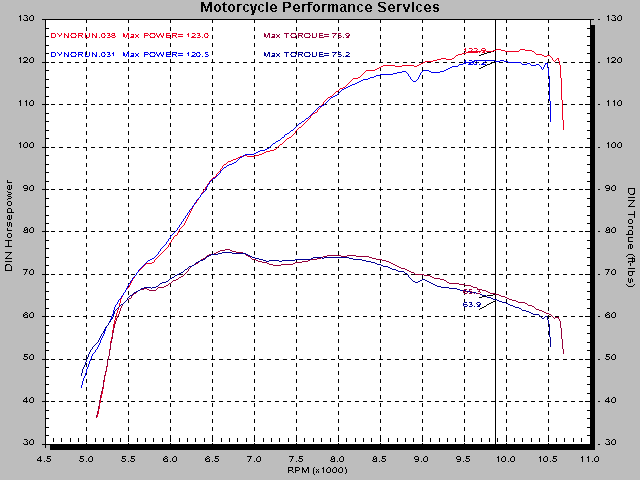
This last season I had the opportunity to service several of the 996s that were sold in this area, and ran several of them on the dyno.
I was impressed with the power output compared to the 916s. They seemed to make their power low in the RPM range (like a 916.)
Another thing I noticed, the stock Ducati 074UCH chip seemed to be a very good piece. I tested some of the 996s with FBF chips and one with an Arrow chip from someone in England and they all worked pretty well, although they were a little rich everywhere.
When I checked them I found they were identical and the ignition map and rear cylinder map were stock Ducati maps. The main fuel map was a stock Ducati map with limited changes (+3 over the whole map and –1 from1000-2700 RPM, 2 degrees to WOT.)
Imitation is the most sincere form of flattery, which confirms my suspicions that the stock chip is pretty good. (That and the fact that the others are too rich?)
The FIM chip seems to work nearly the same as the stock one but it can be adjusted, so ultimately it works the best.
Below are the dyno runs of a couple 996s with Termignoni slip-ons and stock chips. All of the charts below are generated with Dynojet WinPEP software and this allows a choice of correction factors. The SAE correction factor is the same (on US models, anyway) as the correction factor used by the older DJPEP (DOS) software.
The correction factor I used for the charts in this article is the DIN.

As I gathered more data from the 996s I noticed there was the dip or stutter just over 9000 RPM. That seemed to be common to all of the 996s.
When that finally sunk in, I asked Duane Mitchell (MR. FIM) if he could make a chip with an extra RPM set point.
Well, not really an extra one because the maps only allow 16 RPM and 16 throttle position set points.
I decided that we could get along without the 7800-RPM point since all of the torque curves seem very flat through that zone.
When I baseline tested Mike’s 996S, first, it was horribly rich (enough that the plugs were sooted and shorting-out at 8500 RPM) and after installing an FIM UM191 chip and leaning the mixture, I noticed that the power began to rise again at 10,000 RPM. You can notice that tendency a little in the chart above.
Next is a chart showing the baseline of Mike’s. Dynorun.003 was cutting out from the sooted plug.
Dynorun.006 shows the improvement with the stock chip installed, (still mis-firing at 9100 RPM) and Dynorun.011 shows the improvement from leaning out a UM191 chip.
All of these runs were performed with the plugs slowly burning the soot off of them. I didn’t change plugs because I was going to take it apart for the 6000 mile check.

When Mike’s bike was finished having the valve clearance set and the cam timing adjusted, we began testing chip changes.
The first few runs were encouraging from the standpoint that the power curve was smoother thru the 9000-RPM range but the power wasn’t as much of an improvement as I had hoped for.
I tried removing the ECS air-filter and discovered that it had been installed over the front velocity stack a little haywire (that would be me!!!) and slipped over the mouth after a few runs. That caused the last couple runs to loose some power.
Finally, Mike had been interested in the 51mm ‘Forza” system that I had hanging in the shop, and, frankly, I was curious to see it’s effect on the 996.
After I had a pretty good calibration we added a little ram air effect. (I extend the inlet air to the front wheel of the bike with a 10” diameter duct, it has a velocity of 80 MPH.)
The result is shown below. Compare it with the baseline.

The only hardware that was added to this bike is the Ducati Performance CF inlet ducts and the 51mm exhaust system. This model has the same engine parts as a stock Strada or Biposto, so the potential is the same.
It seems that quite a few people are thinking that the hardware is the sole reason that this project made good power.
The 51mm system is only part of the result. Following is a chart which shows the difference between tuned and tweaked, and tuned and tweaked with a pipe. There was a little more chip work after that, and both of these tests were done without an air-cleaner (mentioned earlier in this report.)
The point is; these kind of performance improvements come through cam timing, careful assembly and a multitude of changes in the fuel injection mapping, both ignition timing and injector time, and about 2.5HP from the pipe. I think that the chip changes played a big part in this result but it has to be confirmed on a few more examples, maybe by someone else.
It's still a 120HP stock 996, even without the 51mm system.
